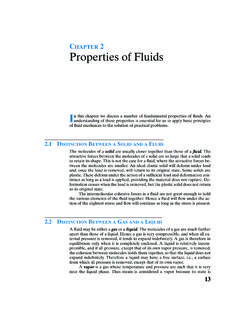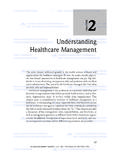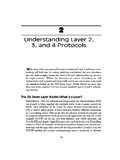Transcription of Environmental Epidemiology - Jones & Bartlett Learning
1 Jones & Bartlett Learning , LLC. NOT FOR SALE OR DISTRIBUTION. Chapter 2. Environmental Epidemiology What are the long-term consequences of beach L earning O bjec t ives pollution? By the end of this chapter the reader will be able to: Does secondhand cigarette smoke cause lung cancer Define the term Environmental Epidemiology in nonsmokers? Describe three major historical events in Environmental Are death rates higher in geographic regions that have Epidemiology Provide examples of epidemiologic tools used in higher air pollution levels in comparison with regions Environmental health that have lower levels? Identify types of associations found between Environmental There is considerable concern today about the chronic hazards and health outcomes health hazards of radiation. Would you consider chem- List study designs used in Environmental Epidemiology icals to be an equal hazard? How large an increase in cancer incidence (occurrence).
2 Would be necessary before a chemical could be identi- Introduction fied as a problem? Several years ago, people were concerned that daugh- In this chapter you will learn that Epidemiology is one of the ters exposed to diethylstilbestrol (DES) would develop fundamental disciplines used in the study of Environmental cancer. What are the chances that this disease will health. For example, Epidemiology is one of the research tools develop in 10 or 20 years in a DES-exposed daughter that seeks answers to the following types of Environmental who does not have cancer now? questions, some of which are adapted from a report by the National Institutes of Environmental Health Sciences:1. Epidemiology is the method of choice to answer questions What is the impact of air pollution on children's lung such as the foregoing ones. Refer to the following text box for function? a further discussion of this issue. Is there a relationship between exposure to agents in Commencing with a definition of the term Environmental the environment and degenerative brain diseases such Epidemiology , this chapter reviews the scope of this discipline as Alzheimer's disease?
3 And defines several of the special quantitative measures used What Environmental exposures might act in combina- to study the occurrence of Environmental health problems in tion with genetic factors to cause breast cancer? populations. Next, the chapter traces the key historical devel- What are the health effects of consuming seafood con- opments in Environmental Epidemiology . Some of these his- taminated with mercury? torical developments include concerns of the ancient Greeks Is it safe to eat tuna, because it could contain chemical about diseases caused by the environment, the observations of pollutants that were dissolved in the ocean? Sir Percival Pott on scrotal cancer among chimney sweeps in 27 11/10/10 5:07:25 PM. Jones & Bartlett Learning , LLC. NOT FOR SALE OR DISTRIBUTION. 28 Chapter 2 Environmental Epidemiology How Do You Study Environmental Health? How do scientists study the effects of Environmental factors such as man-made and natural substances, and radiation on human health?
4 Headlines such as, People in polluted cities have more breathing difficulties are familiar to most of us. They are likely to be about a study of the occurrence of diseases in people who have been exposed to a natural or man-made fac- tor in the environment. That kind of work is called Epidemiology . It is the best known, best understood, and most accepted tool of the Environmental health sciences. It is the type of research that most health regulations are based on. The linking of cigarette smoke to lung cancer (and then to many other conditions) was carried out, in large part, by Epidemiology . To show that link, which seems so obvious today, researchers not only had to compare smokers with nonsmokers over many years, they had to rule out many other exposures these people might have had. Source: Modified and reprinted from National Institutes of Health, National Institute of Environmental Health Sciences. How do you study environ- mental health?
5 NIEHS Fact Sheet #2, 8/96. Available at: Accessed February 11, 2010. England, the work of John Snow on cholera, and later work on sible use of physical and chemical agents, and the psychosocial the role of toxic substances in the etiology of cancer. Closely linked to quantitative measures used by Environmental epi- As noted previously, for an environmentally associated demiology are the major study designs: experimental, quasi- health outcome to be considered a topic of Environmental epi- experimental, and observational (cross-sectional, ecologic, demiology, exposure factors must lie outside the individual's case-control, and cohort). A special concern of the discipline immediate control. Hazards associated with smoking can is causality whether research findings represent cause-and- be explored as an exposure dimension that is either under effect associations. Environmental Epidemiology is a complex or not under the control of the individual.
6 As an example of field that in some cases provides keen insights into environ- the former, studies of the health effects of smoking among mentally caused diseases and in others provides unclear re- individuals who smoke would not be a usual concern of en- sults that must be followed up by other types of studies. vironmental Epidemiology . However, exposure of populations to secondhand cigarette smoke would be a concern because Definition of Environmental nonsmokers and vulnerable groups such as children cannot Epidemiology control whether they are exposed to Environmental tobacco Epidemiology is concerned with the study of the distribution smoke. and determinants of health and diseases, morbidity, injuries, Thus, traditionally, Environmental Epidemiology has disability, and mortality in Epidemiologic stud- tended to focus on health effects linked to degradation of the ies are applied to the control of health problems in popula- air we breathe, the water we drink, and the food we With tions.
7 Epidemiology is one of the core disciplines used to the advances achieved during the 20th century in environ- examine the associations between Environmental hazards and mental sanitation and control of disease-causing biological health outcomes. The term Environmental Epidemiology refers organisms, attention to chemical and physical impacts upon to the study of diseases and health conditions (occurring in the environment has increased. Some of the agents and en- the population) that are linked to Environmental ,4 vironmental factors being focused on are lead toxicity, par- The exposures, which most of the time are outside the con- ticulates from diesel exhaust, and exposures to pesticides and trol of the individual, usually may be considered involuntary halogenated compounds. The last category includes polychlo- and stem from ambient and occupational environments. 5 rinated biphenyls (PCBs), which through biological processes According to this conception of Environmental epidemiol- can become increasingly concentrated in foodstuffs, can pose ogy, standard epidemiologic methods are used to study the hazards as potential carcinogens, and can impact the repro- association between Environmental factors (exposures) and ductive system.
8 More recent concerns of Environmental health health outcomes. Examples of topics studied include air and include the reemerging infectious diseases (see Chapter 5) and water pollution, the occupational environment with its pos- the effects of climate changes due to global warming. 28 11/10/10 5:07:26 PM. Jones & Bartlett Learning , LLC. NOT FOR SALE OR DISTRIBUTION. Contributions of Epidemiology to Environmental Health 29. Although the relationship between Environmental ex- Use of Observational Data posures and their unknown hazards remains a concern of In examining the occurrence of health and disease in human Environmental Epidemiology , the field has evolved to include populations, researchers often are prohibited from using ex- a broader approach: identification of previously unrecognized perimental methods because of ethical issues such as potential exposures to known hazardous agents and the quantification dangers to subjects.
9 Studies of the population's health pres- of such risks; estimation of the amount of exposures that in- ent a challenge that is partially met by Epidemiology because dividuals have to Environmental hazards; assessment of risks Epidemiology is primarily an observational science that takes associated with exposures (discussed in Chapter 3); and evalu- advantage of naturally occurring situations in order to study ation of procedures to prevent Similarly, in the the occurrence of disease. related field of occupational health, the goals of epidemiologic research encompass the description of exposure response Methodology for Study Designs gradients, discovery of how occupational hazards may cause In the realm of Environmental health, epidemiologic research harmful effects, characterization of vulnerable workers, and generally aims to portray the frequency of disease occurrence input into programs for the prevention of occupationally in the population or to link disease outcomes to specific ex- related In order to research environmentally caused disease Contributions of Epidemiology in the population, the field of Environmental Epidemiology to Environmental Health uses characteristic study designs: cross-sectional, ecologic, case-control, and cohort.
10 For example, these methods are Epidemiology aids the Environmental health field through: useful in and linked closely to the field of risk assessment (dis- Concern with populations cussed in Chapter 3). Smith writes, The epidemiologic input Use of observational data to Environmental risk assessment involves the interpretation Methodology for study designs of epidemiological studies and their application to estimat- Descriptive and analytic studies ing the potential health risks to populations from known or Epidemiology is important to the study of environmen- estimated Environmental exposures. 10(p124). tal health problems because (1) many exposures and health effects associated with the environment occur at the popula- Two Classes of Epidemiologic tion level; (2) the epidemiologic methods of natural experi- Studies: Descriptive and Analytic ments and observational techniques are appropriate; (3) the The term descriptive Epidemiology refers to the depiction of study designs used in epidemiologic research can be applied the occurrence of disease in populations according to clas- directly to the study of Environmental health issues; and (4) sification by person, place, and time variables.


















